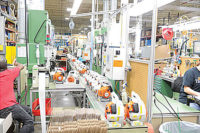As any college football fan knows, the Southeastern Conference (SEC) takes sports seriously, with numerous gridiron rivalries. An engineering professor at the University of Tennessee has come up with a way to transfer some of that competitive spirit to the world of manufacturing.
The school recently hosted the inaugural SEC Machining Competition, with four teams going head-to-head on the factory floor of the Machine Tool Research Center at the new Manufacturing and Design Enterprise building in Knoxville.
The event attracted 40 undergraduate and graduate students from Auburn, Mississippi State and Texas A&M, in addition to Tennessee. They were challenged to use three-axis CNC machine tools to create an aluminum quadrant of the SEC logo. Each segment of the logo measured 12-by-12-by-2 inches and was made out of 6061-T6 aluminum plate.
The teams were judged on criteria such as machining cost, which included time and tools, and part accuracy, which compared measurements and tolerances. Variables that judges looked for were dimensional accuracy, smoothness, speed and surface finish.
“At first, we planned to have each team machine a common part, a true point-to-point comparison,” says Scott Smith, acting section head for precision manufacturing and machining at Oak Ridge National Laboratory (ORNL), who served as lead competition judge. “But, the more we thought about the spirit of competition, we realized that the SEC logo, broken into quadrants, had equitable complexity.
“It seemed like a better idea to have each team machine one quadrant of the logo and have all four teams form the SEC logo together,” notes Smith. “In the end, we are all working together.”
Audience members included middle- and high-school students from around East Tennessee, as well as Greene Technology Center. The one-day event was organized by Project MFG, an organization that puts on local, regional and national competitions to “promote the prestige of manufacturing, accelerate the manufacturing trade workforce training and education pipeline, and collectively level up the broader manufacturing industrial base.”
“We also had multiple industry and government partners that hosted booths at the event to interact with competition participants,” says Tony Schmitz, Ph.D., a mechanical engineering professor at the University of Tennessee. Participants included manufacturers such as Caterpillar and Denso, suppliers such as Kistler and Zeiss, and organizations such as ORNL and the Smart Factory Institute.
“At the heart of the competition is a goal to better prepare students for competitive careers by merging engineering theory and design work from the classroom with production experience using industry-relevant machine tools,” explains Schmitz.
Schmitz was inspired to create the manufacturing competition based on his experience playing college football. “I played at Temple University, and coached high school and college football, so combining my two passions, football and manufacturing, is natural for me,” he points out.
“We know the SEC is big in athletics,” adds Schmitz. “We’re going to make the SEC big in manufacturing. We anticipate that the students who compete, and the students that we’ll touch through programs like this, will be reinvigorating manufacturing in the U.S. as they become the thought leaders, the company owners and the engineers who press us forward.
“This competition is indicative of my entire research career,” says Schmitz. “I’ve spent 20 years thinking about machine tools and how to teach about them. When people think about the manufacturing workforce, they often think about people running equipment. That’s important, but I think about more—the people who design the equipment and the processes.”
The inaugural SEC Machining Competition was won by the University of Tennessee in a closely fought contest. The nearest challenger was a team of students from Texas A&M that comprised eight engineering undergrads. The Aggies made a strong start, but soon realized that their fixture had been improperly installed.
“After fixing the issue, they finished with the competition’s best time of 74 minutes and 57 seconds,” says Darrell Wallace, Ph.D., the Aggie team advisor and professor of practice in the Department of Engineering Technology and Industrial Distribution at Texas A&M. “Though the Tennessee team’s time was longer, their careful use of fewer tools and their proficiency in achieving excellent surface finish gave them enough of an advantage to claim the inaugural title.”
The 2023 event will be held in mid-November, and Schmitz expects up to 10 schools to participate this time. His long-term vision for the competition is to expand it to include all 14 SEC universities and eventually other conferences across the nation, such as the ACC and the Big 10.
“An excellent outcome would be a national championship where conference winners compete,” says Schmitz.
“This event is representative of what we need across this country,” adds Adele Ratcliff, director of the Industrial Base Analysis and Sustainment Program at the U.S. Department of Defense. “We are better when we join forces, we are unified, we are a strong chain together.
“We need to be able to recruit the next generation in, we need to be able to train them to higher standards, and we need industry to be involved to send that demand signal and create that close relationship with these next-generation students,” claims Ratcliff. “It takes a united front to do that, of all interested stakeholders in this space of manufacturing.”
About the Author
Austin has been senior editor for ASSEMBLY Magazine since September 1999. He has more than 21 years of b-to-b publishing experience and has written about a wide variety of manufacturing and engineering topics. Austin is a graduate of the University of Michigan.











